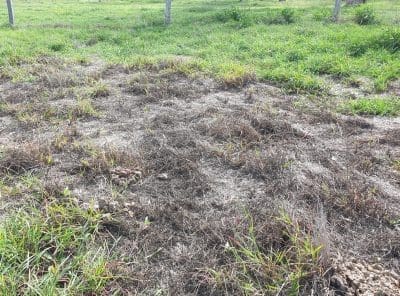A $5.4 million industry/government investment is being made in new research projects investigating pasture dieback amid concerns over its re-emergence following widespread rain across parts of Queensland.
Meat & Livestock Australia has been awarded a $2.7 million grant from the Federal Department of Agriculture, Water and the Environment to help fund research and development and has committed an additional $2.7 million to match the grant funding with producer levy investment.

Small patch of pasture dieback
Part of the grant is funding R&D investigating pasture mealybug as a possible cause of the devastating condition, led by Queensland University of Technology microbiologist, Associate Professor Caroline Hauxwell.
MLA recently called for full applications from research organisations with the capability to undertake R&D into on-property monitoring, control methods, and mitigation actions for pasture dieback. These are currently being assessed. This recent call will support the Federal Grant implementation as well as additional work on causal factors and solutions across Queensland and New South Wales.
Pasture dieback has been periodically observed over the past 30 years, however in 2017 red meat producers across parts of central Queensland reported widespread dieback of both sown and native pastures. It has since been observed across southern to northern Queensland, and most recently has been confirmed on the north coast of NSW.
MLA managing director Jason Strong, MLA board director Russell Lethbridge and MLA general manager for research, development and adoption, Michael Crowley, were on the ground in central Queensland recently to meet with impacted producers and AgForce representatives on the issue.
Mr Crowley said while pasture mealybug was seen as a likely contributor to pasture dieback, it is vital the exact cause or causes need to be validated with certainty.
“While R&D projects investigating pasture mealybug are underway, it is vital to investigate other possible causes, management interventions, and undertake detection and monitoring,” he said.
While widespread rain across many parts of Queensland this year had transformed drought-hit pastures, it had also sparked a re-emergence of pasture dieback.
“Ongoing drought had made it difficult to tell the difference between pasture dieback and the impacts of drought. However, the widespread rain is starting to reveal the true extent of the problem,” Mr Crowley said.
“This R&D is just one of the ways MLA is working to help identify the cause of pasture dieback and develop effective management measures and solutions for producers.
“MLA initiated a multi-pronged plan to address pasture dieback when it first emerged and we continue to work with a range of research providers, producer networks, the Queensland Department of Agriculture and Fisheries and NSW Department of Primary Industries, to capture and exchange information, and support producers to take action on-farm.”
AgForce Cattle chairman Will Wilson has been at the front line of the issue.
“Pasture dieback is the number one priority for central Queensland beef producers,” Mr Wilson said.
“Whilst many parts of the region have experienced a decent break in the season, it is vitally important that efforts to address this issue are not masked by the improved conditions.
“AgForce and its members are following closely the investments MLA is making and are providing robust input into the direction of current and future work. We are confident the increase in investment and effort will deliver valuable outcomes for the industry.”
Source: MLA

Hi Will.
I watched the Landline show on your dieback problem.
We have had some trials going with our wormhit pellets in Pasture out from Rockhampton and waiting on soil tests at present form the trial area.
We have seen pest problems down on irrigation and dry land farms disappear once their soil is treated to a dose of new microbes from our wormhit pellets.
I would be happy to discuss more trials now that there is a bit more moister around as our microbes need moister to active.
regards
Chris Curran Wormhit Mildura
Spot on Wally. Same comment applies to the Queensland Ratstail research.
It makes you wonder how serious they are in investigating this.
Looks like this funding is a smoke screen
This is becoming a very serious problem within the grazing industry
R&D into die-back over the last few years has not produced much. New funds should go to a new team